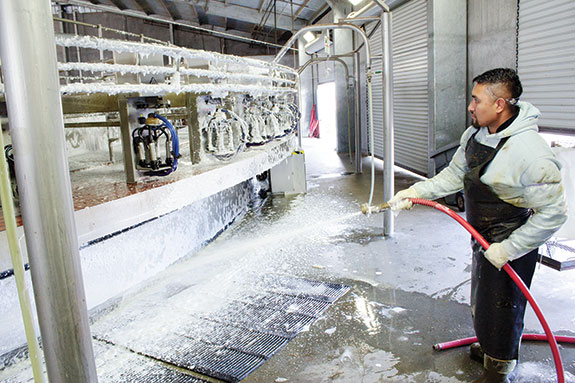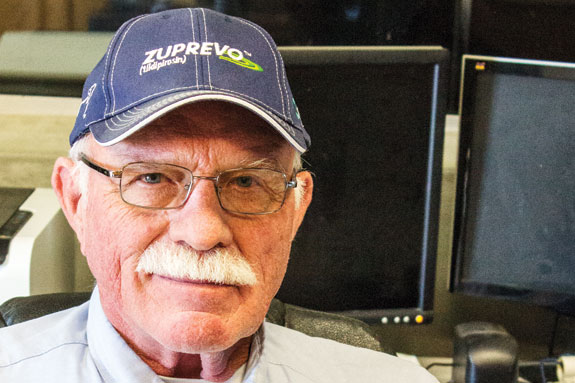Watching two 80-stall, back-to-back rotary parlors milk a combined 6,500 cows twice per day would amaze just about anyone.

Tell a dairy producer the same dairy has collared each of its cows with activity monitors, unofficially becoming the largest activity monitoring system in North America, and most would say the dairy has it all.
Yet for owning what is akin to the Cadillac of dairy facilities, Bar 20 Dairy co-owner John Shehadey and his son, Steve, say it’s not all for their personal gratification but for the cows and the dairy’s margin.
“In today’s business climate, whether you’re in the dairy business or any other business, you’ve got to be as efficient as possible,” Steve says. “With the number of cows we have, any tool we can get to help us take better care of our cows is something we think is worth investing in.”
Unassuming falls short in describing the father and son, who inherited a dairy legacy from John’s father, Larry A. Shehadey, for whom the new dairy is formally named.
Larry began milking cows after buying into a milk processing business in Fresno, California, in 1949. He soon questioned why the plant couldn’t produce milk for itself instead of buying milk from a number of different dairies.
In 1959, Larry built the family’s first 400-cow dairy in Fresno, vertically integrating his supply chain. Since then, his sons and now grandson have expanded the herd, building two dairies which now supply about one-third of the milk processed under the Producers Dairy label. John’s brother Richard is a co-owner of Bar 20 Dairy and manages the processing side of the family’s fluid milk business.
“I think my father would be most proud that Steve has come into the business and that he has an interest in it,” John says.
As operations manager for the family’s two dairies, 45-year-old Steve meets with his father and top supervisors, dairy manager Stan Marks and herd health manager Ron Freitas, weekly to review the dairy’s key performance indicators, which include milk production, culling, death loss, dry matter intake and more.
Steve and his day-to-day managers have found that improvement now comes through investing in technology and training supervisors and employees to use it.

Yet while Steve finds technology valuable, he says he still remembers what his grandfather always told him:
“We’re only as good as the employees we work with.”
Because the dairy has several precision management systems, including a feed management system, hand-held herd management software and in-parlor milk monitoring, it can measure employee performance and does so, providing incentives for employees who reach the dairy’s benchmarks for milk quality, herd health, feeding accuracy and breeding.
“On smaller dairies, a herdsman or single dairy manager can take care of problems by themselves,” Steve says. “Now we do a lot of training with department supervisors to make sure they empower their employees to solve problems.”
For example, Marks says that after installing the dairy’s expansive activity monitoring system about a year ago, he spent a lot of time training supervisors to trust the system. He calls the results so far “very successful” after seeing how it saves time sorting cows and now that the dairy’s preg rate has increased by 2 percent.
“As we continue to train people how to use it and have confidence in it, I think we will see continued improvement,” Marks says.

Since the installation, Marks says he’s learned the key to the successful use of activity monitoring is cattle tags and identification.
“If you don’t have cows ID’d, you don’t have anything but data and nothing to associate it with,” Marks says.
Making sure every cow is constantly identified with a working RFID ear tag is a basic but regular task on the dairy.
“We run a ‘missed cow list’ every week,” Marks says. “That list is given to an employee on days when we’re not doing vet checks in order to go out and find out what’s wrong with the cows on the list. We’ve never had zero cows show up on that report. But we’ve got it down to just one.”
The dairy also uses a unique three-gate sorting system, which sorts more than 100 cows per day, for treatment, culling or pen moves.
“The sort gates alone save employing a couple of full-time employees,” Marks says.
Steve likes that managers and employees don’t just use the activity monitoring system and sort gates to breed cows but to identify low-activity cows too.
“If we can catch a cow that may be having a problem before she gets too bad, we may be able to save her,” Steve says.
As the dairy has been expanding and purchasing cattle, Steve acknowledges the dairy’s involuntary culling has been higher than he would like. Since beginning the expansion six years ago, the dairy just recently started having enough replacement heifers to close the herd again and even sell a few extras.
“Our top animals are doing well,” Steve says. “We are now trying to improve the bottom part of the herd by culling less productive animals and replacing them with more productive ones. You can’t afford to keep less productive cows when feed prices are at record levels.”
As the dairy continues to improve herd health and cow longevity, all of the dairy’s technology now focuses on achieving increased per-cow milk production. Marks sees that new technologies will continue to help with that.
“I see that monitoring milk components as the cow is milked is something we will see in the future. Robotic milking is probably not that far away. We’ll also be able to detect with milk if a cow’s in heat or pregnant,” Marks says. “I see that it will take fewer people to do the same jobs. Less labor is not that far away.”
While Marks and others on the dairy may have fewer employees to supervise, he admits that managing a dairy will only become more technical.
“Even if you could totally automate a milking operation, it’s still going to take one person to oversee it all,” he says. “You’ll need people who can manage technology, maintain equipment and run computer software.”
Looking for continued improvement, and in the 21st century that means the application of technology, has been and continues to be a deep family tradition for the Shehadeys.
“My grandfather always tried to do a little better each day,” Steve recalls. “If we can continue to do that today, then five years from now, we’ll still be around.” PD
PHOTO 1: An employee at Bar 20 Dairy cleans equipment in one of the two rotary parlors the dairy uses to milk 6,500 cows twice per day.
PHOTO 2: Stan Marks is one of two supervisors who help Bar 20 Dairy stay on schedule and meet the needs of the dairy on a daily basis. Photos courtesy of Ray Merritt.
Click here to watch sneak peek videos and virtual tours of each of the farms presented during the World Ag Expo seminars.

-
Walt Cooley
- Editor-in-chief
- Progressive Dairyman
- Email Walt Cooley






